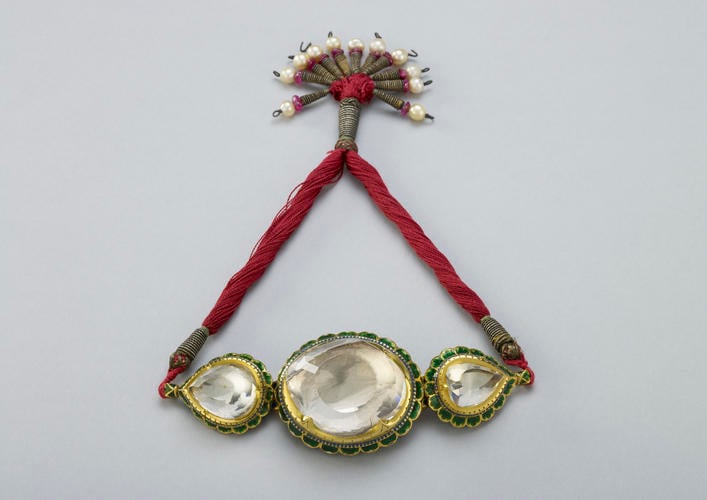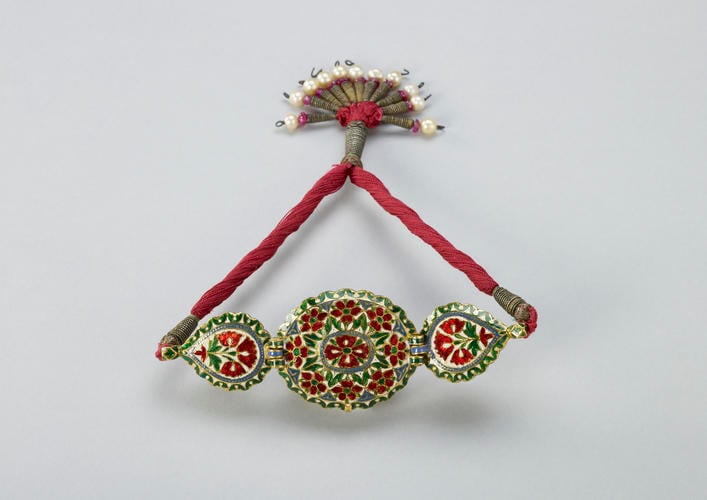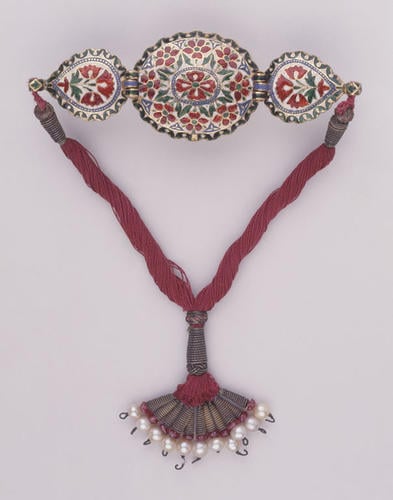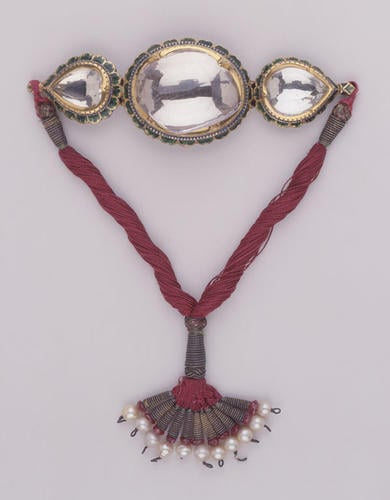-
1 of 253523 objects
The Koh-i-nûr armlet c. 1830
Gold, enamel, rock crystal, glass, rubies, pearls and silk | 10 x 15 cm (excluding fittings) | RCIN 31734

Garrard & Co
The Koh-i-nûr armlet c. 1830

Garrard & Co
The Koh-i-nûr armlet c. 1830

Garrard & Co
The Koh-i-nûr armlet c. 1830

Garrard & Co
The Koh-i-nûr armlet c. 1830




-
This armlet is formed of quartz and glass replicas of the Koh-i-nûr and its accompanying diamonds, enamelled on the reverse with stylized floral devices. Red silk ties bound with gold terminate in a tassel with pearls and rubies.
Known in Persian as Koh-i-nûr (‘Mountain of Light’), the diamond is one of the most contested gemstones in history. Following its probable discovery in India in the fifteenth century, the diamond passed between Persian shahs, Afghan kings and Indian emperors, frequently changing hands through bartering and warfare. The first undisputed account describes it set into the glittering ‘Peacock Throne’ of Mughal emperor Shah Jahan, commissioner of the Taj Mahal. It was captured by the Persian emperor, Nader Shah, when he invaded Delhi in 1739.
By 1813 the diamond formed part of the treasury of Sikh ruler Ranjit Singh in the Punjab (now north-western India). When the British expanded into this territory in 1849, they forced his young son, Maharajah Duleep Singh, to sign a treaty renouncing his sovereignty and transferring the region’s assets to the British. This stone was singled out for surrender to Queen Victoria. The diamond, set in this armlet, was delivered to Buckingham Palace by the President of the Board of Control at the East India Company on 3 July 1850.
Queen Victoria and Prince Albert both felt that the Koh-i-nûr was badly cut and disappointingly lacking in brilliance. The diamond and two side stones were examined in detail by Sebastian Garrard on 9 April 1851, and subsequently recut. At the same time, a mould was taken, and between July and September 1852 a crystal facsimile was made. This facsimile now forms the armlet.Garrard’s devised a number of alternative settings for the original stone. The queen wore it frequently as a bodice brooch, but it could also alternate with the Timur Ruby as the centre of a necklace. The two side stones were used as pendants on the Timur Ruby necklace, but after the return of the Hanoverian jewels in 1858, Garrard’s made them detachable for use as drop earrings to accompany the newly made Coronation necklace.
Since its arrival in England the Koh-i-nûr has only been worn by queens regnant and consort due to a legend which states that it will bring bad luck if worn by a man. After Queen Victoria's death the stone has been mounted successively in the crowns of Queen Alexandra, Queen Mary and Queen Elizabeth (consort of George VI) – see RCIN 31703.
The rock crystals now in this armlet represent the original form in which the Koh-i-nûr diamond arrived from India.
Provenance
Surrendered to Queen Victoria in 1850 and reset with facsimile stones by Garrard's in 1852.
-
Creator(s)
(jeweller)Acquirer(s)
-
Medium and techniques
Gold, enamel, rock crystal, glass, rubies, pearls and silk
gold, red enamel, green enamel, blue enamel, pearl, glass (material), thread, silk (textile), ruby, quartz crystalMeasurements
10 x 15 cm (excluding fittings)
140.0 g (Weight) (whole object)
Alternative title(s)
The Indian setting of the Koh-i-nûr